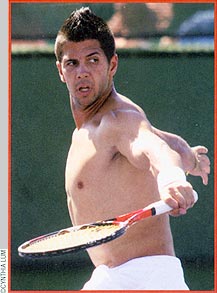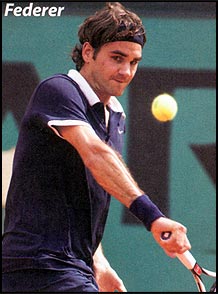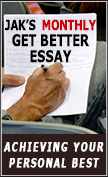JUNE 2009
HOW MANY HANDS DOES IT TAKE?
I always enjoy asking players: “How many hands does it take to hit a one-handed backhand?” Most answer, incredulously, “one.” Some, recognizing the trick question, smile and state “two,” knowing that they have offered the mechanically correct answer, despite, all too often, not really utilizing that second hand themselves.
At this juncture in the game’s evolution even tour pros with two-handed backhands have learned to play a serviceable one-hander as well, especially when stretched out wide or moving forward for a low approach that has landed very short. So, read on two-handers!
A key component in developing a rock solid one-hander is being able to remain sideways to the net, beginning at first recognition and then maintaining that hip-shoulder alignment throughout the follow through’s end.
 Current top tenner Fernando Verdasco illustrates this perfectly on the practice court (down girls!). He has fully completed his follow through on a slice backhand that will stay low through the air and then skid nastily off the bounce – widely labeled “the knife” on tour but referred to by Vivante at Punta Gorda, Florida players as “the slimer,” i.e. “you got slimed.”
Current top tenner Fernando Verdasco illustrates this perfectly on the practice court (down girls!). He has fully completed his follow through on a slice backhand that will stay low through the air and then skid nastily off the bounce – widely labeled “the knife” on tour but referred to by Vivante at Punta Gorda, Florida players as “the slimer,” i.e. “you got slimed.”
Note his off-arm, being a lefty his right arm, has remained behind his body and has even moved a bit further behind during the shot to function as an anchor maintaining balance. This also insures free flowing racket head speed through impact, a technique that cannot be achieved if the off-arm moves forward with the racket allowing the hips and shoulders to rotate in the strike zone. Not good!
 Roger Federer, owner of one of the best one-handed backhands of all-time – think also Rod Laver and Justine Henin – is shown hitting a topspin backhand, not that he does not employ the slice regularly. Notice the racket head approaching impact from well below the projected contact point, opposite of the slice which moves from high to low through the ball. Once again, the off-arm trails behind the body resulting in the same efficient sideways position as Verdasco through the stroking path, although this time with a closed face grip for top versus the Spaniards open face grip for underspin.
Roger Federer, owner of one of the best one-handed backhands of all-time – think also Rod Laver and Justine Henin – is shown hitting a topspin backhand, not that he does not employ the slice regularly. Notice the racket head approaching impact from well below the projected contact point, opposite of the slice which moves from high to low through the ball. Once again, the off-arm trails behind the body resulting in the same efficient sideways position as Verdasco through the stroking path, although this time with a closed face grip for top versus the Spaniards open face grip for underspin.
The non-hitting hand is also instrumental in pulling the racket back from the ready position during the grip change and the initial turn into the ball. Each arm, ideally, functions primarily in only one direction – the off-arm draws the racket back then allowing the hitting arm to accelerate freely through the ball without any undermining, last second hitches typical of those who are “one-armed” strikers. The transition is smooth and surprisingly powerful with both underspin and topspin.
In the ready position it’s also the off-arm, better yet in this instance the off-hand, at work again. This time one’s left hand (right-handed player) is positioned up high on the racket’s throat – better to feel the racket heads position - with a slightly elevated tension while the hitting hand is barely touching the grip. Once an approaching backhand is recognized the off-hand/arm is triggered, now completely unencumbered, to prep the racket fully in a singular movement by the time the ball bounces with the racket hand poised to unleash the racket through the ball.
As a young player, my backhand, fortunately, was solid early on. Having had the advantage of observing “The Rocket” up close and personal on numerous occasions during the early pro tour days before tennis went “open” in ‘68 - search “Handsome Eight” – I was able to develop a one-handed backhand that was not at all a liability. Luckily, albeit just a couple of years later, I’m still able to rely on my backhand as an asset.
Believe me. Trust me. You can too!!
Questions and comments are welcome at anytime for all tips present and past via email.
This Tip of the Month is copyright© by Jak Beardsworth Tennis. All rights reserved. Copies may be made only with the permission of and by Jak Beardsworth. Contact him here.
Tips Archive
- May, June, 2013 JUST TALKING HEADS OR MORE [read more]
- March, April, 2013 SELF-TALK: Good, Bad, or Indifferent [read more]
- January, February, 2013 BOOK-A-MILLION: Do Tennis Players Read? [read more]
- December, 2012 THE KEY TO TOUR LEVEL BALL STRIKING: And How to Learn It [read more]
- November, 2012 ARE YOU A THUDDER, A TWANGER, OR A PINGER: Racket Dampeners [read more]
- September, October, 2012 SMART SHOTS [read more]
- July, August, 2012 TEN TOP STRESS REDUCERS [read more]
- June, 2012 MAKING YOUR LESSONS STICK [read more]
- May, 2012 THE IMPOSSIBLE: Accelerating and Decelerating Simultaneously [read more]
- April, 2012 PLAYER DISCONNECTION [read more]
- March, 2012 BENDING THE SERVE IN [read more]
- February, 2012 UNDERSTANDING TERMINOLOGY: Drill vs Clinic vs Team Practice [read more]
- January, 2012 PLAYING SCARED? [read more]
- December, 2011 CUTTING OFF THE ANGLE…VERTICALLY [read more]
- November, 2011 WHY COACHING? [read more]
- October, 2011 THE EASY BALLS ARE NOT EASY [read more]
- August/September, 2011 NEVER TOO LATE FOR OLDER DOGS [read more]
- June/July, 2011 HARD COURTS, SOFT COURTS, and YOUR BODY'S ADAPTATION [read more]
- April/May, 2011 JAW DROPPNG [read more]
- March, 2011 CLUB DOUBLES' INCREASINGLY MISSING LINK [read more]
- February, 2011 TIP 2 | POOH POOHING DOUBLES STRATEGY SESSIONS [read more]
- February, 2011 TIP 1 | CLAY TO HARD, HARD TO CLAY [read more]
- January, 2011 ICING THE SERVER WHEN RECEIVING IN THE BIG MOMENTS [read more]
- December, 2010 JOHN ISNER’S “GOOD MISS” [read more]
- November, 2010 THE MOST NEGLECTED SHOT IN THE GAME [read more]
- October, 2010 BALL BOUNCING and the SERVE [read more]
- September, 2010 TAKE YOUR EYE OFF THE BALL [read more]
- July-August, 2010 SUMMER SCHOOL COURTSIDE CRIB SHEET [read more]
- May-June, 2010 THE 2-HANDED JUMP BACKHAND: The Dumbest Shot in Tennis [read more]
- April, 2010 THE STANDING AROUND SYNDROME [read more]
- March, 2010 THE ELUSIVE SERVICE TOSS [read more]
- February, 2010 PREPARING TO START THE POINT: Serving and Receiving [read more]
- January, 2010 DEBUNKING THE MODERN GAME [read more]
- December, 2009 RELAX – IT'S JUST A RALLY BALL [read more]
- November, 2009 DEFEATING THE POACHER [read more]
- October, 2009 PRACTICE, PRACTICE, PRACTICE [read more]
- September, 2009 SERVING SUCCESS: Warming-Up vs Match Play [read more]
- August, 2009 THE SPLIT STEP: Defending the Court, Rushing the Net, and More [read more]
- July, 2009 THE THIRD GROUNDSTROKE [read more]
- June, 2009 HOW MANY HANDS DOES IT TAKE? [read more]
- May, 2009 THE MOST IMPORTANT SKILL [read more]
- April, 2009 PLAYING IN THE FLORIDA WIND [read more]
- March, 2009 Letting them Play for Peak Performance in Clubland [read more]
- February, 2009 SUPPORTING YOUR GAME [read more]
- January, 2009 RESPECTING THE GAME: Top 10 Do's & Don'ts [read more]
- December, 2008 Getting the Warm-up Right [read more]
- November, 2008 Visualize...Realize: The Mind Body Connection [read more]
- October, 2008 Reading Their Mail [read more]


